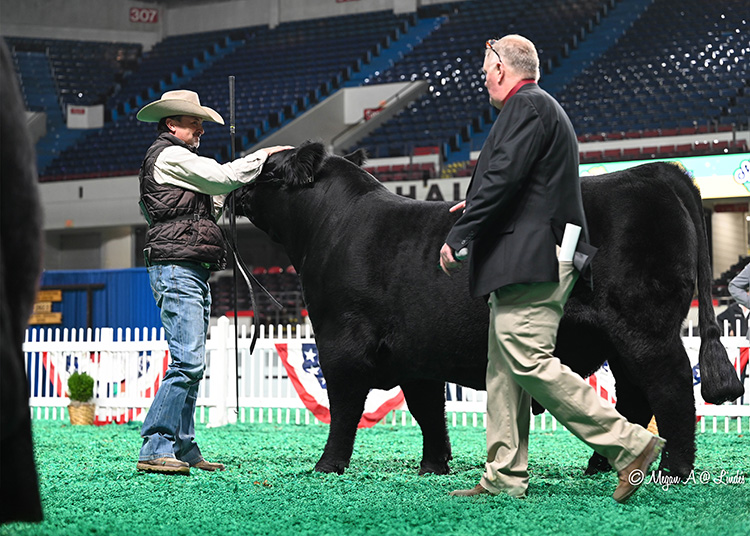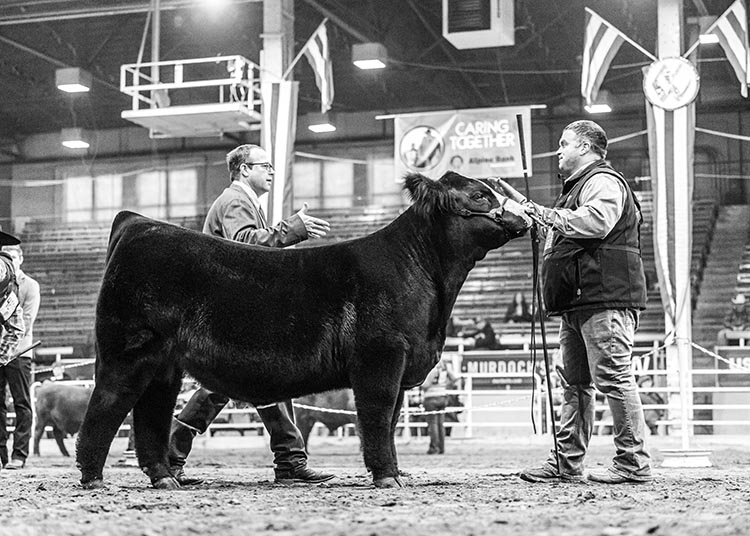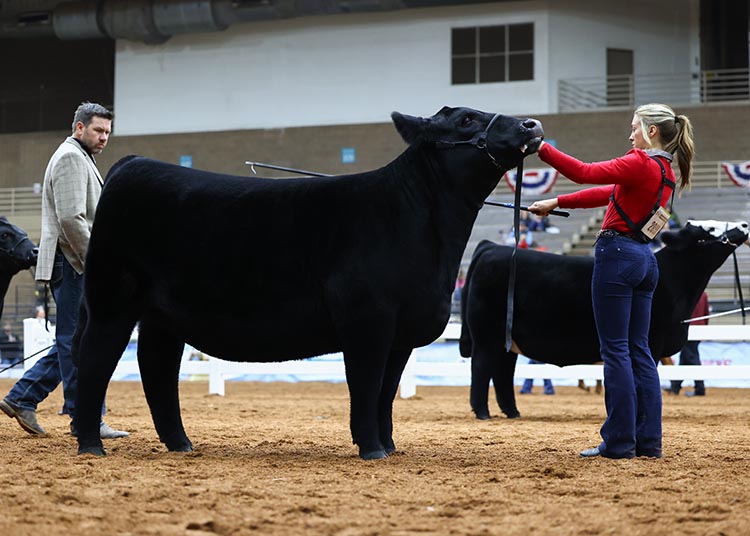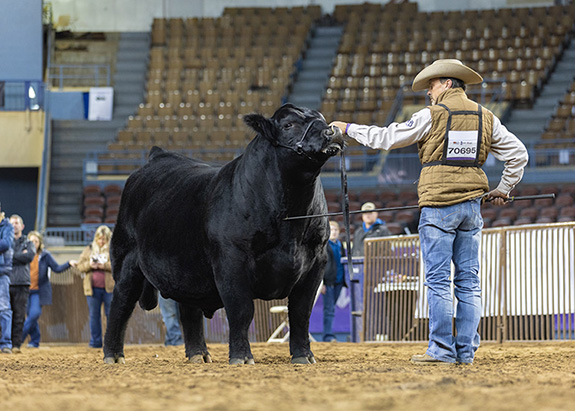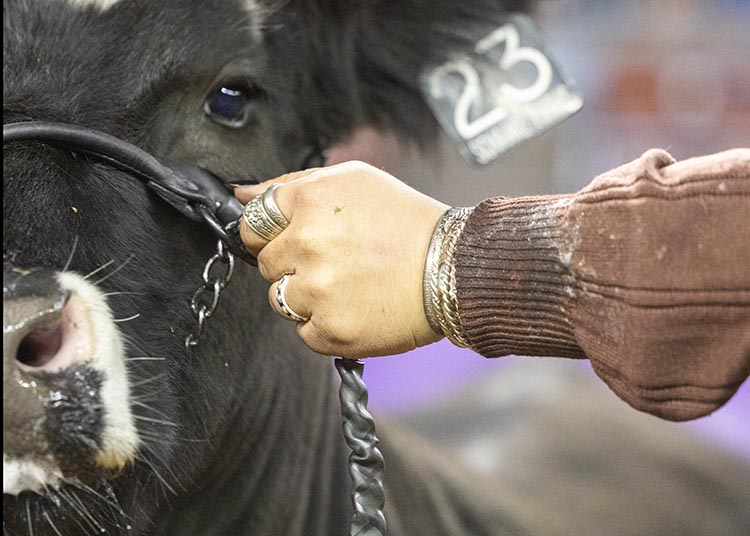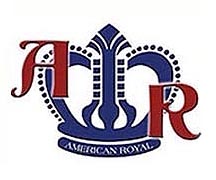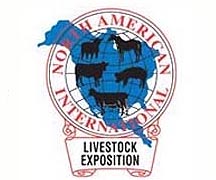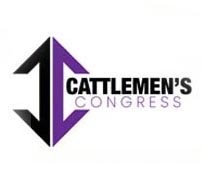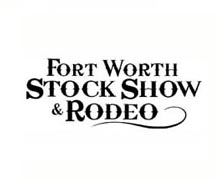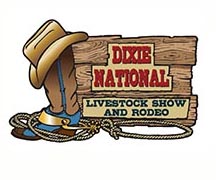Progress Through Performance (PTP)
The American Simmental Association Presents Progress Through Performance Shows.
PTP shows effectively combine the assessment of statistical data, such as EPD and actual measurements, with traditional phenotype evaluation. The primary goal of the PTP program is to promote multi-level progress within the SimGenetics industry.
To learn more about the PTP program, we invite you explore our site and attend our National PTP Shows.
![]() Follow our Facebook page for live show updates and information.
Follow our Facebook page for live show updates and information.
Contact
The Foundation of the PTP Program
PTP Shows Contribute to Our Success: Introduction
This series on topics of show ring seedstock evaluation explores realistic opportunities to continue the advancement of SimGenetic influence on the world’s beef businesses. Is it possible to accurately gauge an animal’s productivity and genetic worth from what we see in the show ring? How do the winners selected in the show ring impact the cow herds around the country? How do show ring decisions influence our downstream customers’ perception of SimGenetic value? In three parts, we discuss skeletal soundness, fat and muscling, and frame size and growth.
On one hand, exhibiting SimGenetics is important to our membership. Shows provide opportunities for ASA members to meet potential customers, review cattle produced by others, get unbiased evaluations from notable judges, and enter conversations about sire selection and production ideas.
On the other hand, each year, hundreds of ASA members who hardly own a rope halter—let alone have the inclination to prepare cattle for either a national show or their county fair—sell huge numbers of bulls and heifers. How does our Association blend and service two significantly different businesses?
For decades, we’ve tried to describe and justify the impacts that seedstock producers can have on genetics when they exhibit cattle and produce show winners. Before ASA initiated Progress Through Performance (PTP) Shows, judging was all about conformation. Traits such as calving ease, marbling, and other important information from our powerful database were ignored. Judges’ selections at shows have altered both the reality and perception of breed types.
By the late 1980s, Simmental and Simbrah genetics were losing the battle for beef industry importance. Popular show-winning SimGenetics were very large-framed, nearly free from fat, and trending in the wrong direction for calving ease, stayability, and carcass quality.
Just look at old Angus and Chi photos, and you’ll see that our breed wasn’t the only one selecting for traits that increased average daily gain (ADG) and reduced fat—genetics that we hoped would improve profits for feedyards and packers. However, back in cow herds, birth weight, mature size, and nutrition requirements to keep cows reproducing were skyrocketing. And, because Simmental/Simbrah started from disadvantaged positions (that is, more birth weight, more milk, and larger mature size than many breeds), we were being pushed to completely unmanageable figures for calving ease, cow size, and steer finishing weights.
It really did take some strong ASA leadership to change the long-held position of hands-off shows, and to convince our members that the addition of genetic information to the show ring would remedy our problems. Positioning SimGenetics as the most valuable Continental maternal seedstock source meant we had to account for every EPD that impacts cow herd profits. ASA’s All-Purpose Index ($API) does that. It is imperative to use an economic index to measure the genetic contributions to cow herd worth if we are to convince cattle producers that Simmental influence will improve their success.
The road to selecting show winners with both superior breeding values and exceptional conformation has been challenging. All of us have witnessed PTP Shows where winners’ EPD profiles were not impressive. (“Those judges paid no attention to the numbers!”) And only in the most unusual circumstances has a physically plain or unattractive bull or heifer received preferential placing because of their paperwork. (“The judge spent all day with his head buried in the paper!”) With audiences primarily oriented toward conformation, it’s exceptionally difficult for judges to put blue and purple ribbons on less-than-beautiful animals even if their EPD are fantastic. We doubt whether the controversy will ever end; however, there seems to be less debate in recent years that soundness, size, and the conformation of exhibited cattle are trending in more industry-friendly directions.
Without question, both genetics and physical features play a role in the success of nearly every cow herd and feedyard, whether they know it or not. Physically attractive cattle catch the eye of potential customers in the pasture, sale ring, and even packer-buyers visiting feedyards. For the good of every SimGenetic breeder in our business, and our members’ customers, there is no reason that we should ignore either conformational or genetic indicators of worth.
PTP Shows Contribute to Our Success: Part Two
Evaluating and Emphasizing Muscle and Fat in Shows.
Contributors: Steve Reimer, Curt Rincker, Marty Ropp, and Dr. Jerry Lipsey
This series on topics of show ring seedstock evaluation explores realistic opportunities to continue the advancement of SimGenetic influence on the world’s beef businesses. Is it possible to accurately gauge an animal’s productivity and genetic worth from what we see in the show ring? How do the winners selected in the show ring impact the cow herds around the country? How do show ring decisions influence our downstream customers’ perception of SimGenetic value? In three parts, we discuss skeletal soundness, fat and muscling, and frame size and growth.
In this segment, we explore how muscling and fatness impact exhibition success, and if show ring trends are friendly to future beef business demand for Simmental genes.
The ASA Carcass Merit Program (CMP) is among the best of all breeds. From CMP and member ultrasound data, ASA produces some of the most accurate Backfat, Marbling, and Ribeye EPD in genetic evaluation history. So, where does that put show ring evaluations and comments on maintaining and improving both maternal and carcass traits?
The position of SimGenetics’ role in crossbred cows is a tight-wire act. Somehow, we must provide cow genetics that easily accumulate enough fat for cow condition scores 5 and 6, yet advance our reputation for superior carcass yield grades in their progeny.
Fat
Our role is genetic contributions to producing better food; obviously, we eat beef, which is a perfect combination of muscle and fat. Ideally, our industry will produce great-tasting beef with just the right amount of intramuscular fat and minimal external waste fat. We have already committed ourselves to wanting a maternal position in beef systems. Too many believe that defines us as not prioritizing carcass traits, which is completely foolish.
Let’s talk fat first. Certainly, visual fatness is more management-driven than the environmental factors that affect muscling. Variation in nutrition, health, weather, and animal age makes for potentially huge variation in condition (fatness) of both bulls and heifers. Since there is massive fat accumulation in the bovine lower body, we wonder if comments concerning depth-of-rib aren’t more fat-driven than real differences in skeletal dimensions. In any event, we have experienced many years of seemingly preferential placement/preference for deeper-bodied—and perhaps fatter—Simmental-influenced cattle.
It’s imperative that we digress a moment and think about the fat accumulation consequences of reproductive cattle vs. finished cattle producing Select, Choice, and Prime carcasses. Science has proven that proper management resulting in cow condition scores 5 and 6 make for higher pregnancy rates than cows with scores of 4 or less (condition scores higher than 6 do not improve rates). On the other hand, if we are ever to produce 70% Choice and 70% YG 2 carcasses, we have to control carcass backfat. Is there a clear-cut relationship between breeding animal fatness and carcass fatness?
Of course, there is a relationship if the animals (heifers or bulls) are birth contemporaries. For more than 20 years, breed association databases proved that information from ultrasound on contemporary bulls and heifers provide powerful influences on our carcass EPD. In the same environment, animals with more “carcass fat genes” nearly always get fatter than those with less genetic drive to fatten. Essentially, every breed association uses ultrasound contemporaries to produce carcass EPD.
So, how can SimGenetics have it both ways? That is: pragmatic body fat storage in breeding animals and industry-leading finished cattle carcass yield grades.
Feed and forages are expensive, the most costly item of cow herd enterprises. All of us would like to use these precious resources efficiently, and judges often comment on and seem to prefer easy-keeping qualities. We assume that judges are taking the perspective that all the animals in the class have had access to similar nutrition and environment; subsequently, judges can perceive the fatter ones as easier keepers. But is this true?
Not necessarily. Fatter cattle could just be individuals that ate more (hence, no more efficient), grew in a more comfortable environment, or were simply offered more feed by owner-exhibitors in order to attract judges to deeper-bodied cattle with copious external fat deposits. This appeal for fatter show females assumes they get and stay pregnant easier (i.e., they are easier to keep in condition scores 5 or 6 through all kinds of weather). But how do judges decide if cattle are too lean or too fat?
If you think this is confusing, it is! The most-proven genetics for Simmental mature cow reproduction (fertile longevity) are contained in Stay EPD. The most important genetics for backfat and yield grade is constantly presented in the ASA carcass EPD.
Since more than 40,000 carcasses and 100,000 ultrasounds have contributed to the accuracy of ASA EPD, the effectiveness of genetic selection for carcass traits strongly favors EPD over visual evaluation of one animal in the show ring, even though we contend muscularity is reasonably assessed by confirmation (more on this later). Since nearly all the animals in show ring classes are non-contemporaries, visual evaluation for genetic fatness in shows is very questionable. Stay EPD is a much more powerful predictor of cow fertile longevity than show ring external fat.
A note before we move on to the subject of muscularity. We occasionally hear judges criticize obese animals, typically heifers. For decades, animal husbandry has documented reduced milk and reproduction resulting from over-fattening. In addition, cow condition scores over 6 do not result in increased pregnancy rates. Clearly, there is a law of diminishing returns relative to cow fatness and how much judges should prioritize “easy-keeping” heifers.
Muscling
Is visual evaluation for muscling effective? There’s every reason to discuss muscling differences in meat animals. By preferentially growing muscle vs. fat or bone, we can greatly influence the efficiency of producing a great-tasting, protein-rich food. Carcass yield grades are reasonably good indicators of percentage muscle in market animals, and the ribeye area is most commonly used to measure differences in muscle thickness.
Similar to our comments on managing carcass fat, the thousands of carcasses resulting from the ASA Carcass Merit Program provide the solid foundation for ASA’s carcass trait EPD. If modifying carcass traits is the goal, no information source rivals our EPD. So, what does that leave for muscling evaluation in shows?
Bull and heifer muscularity, evaluated in terms of body shape, is not as strongly affected as fatness by environmental differences. Likely, judges do a good job of detecting muscularity, so the question is, are we having any impact on genetics for muscling through PTP Shows?
The Simmental genetic trend for ribeye area (REA) has been steeply positive since 1990, and PTP Shows were initiated then. So, isn’t it logical to assume the PTP concept had something to do with the trend for greater muscularity? Contrary to that notion, PTP Show printed programs have seldom provided REA EPD, so judges had little chance to make decisions from our database information.
In addition, over the same years, Angus and Hereford genetic trends for REA are just as positively steep as Simmental, and they did not routinely use genetic data in shows. The best conclusion is that in the early 1990s, seedstock producers intensified visual selection for muscularity. The common 1980s-era term, “late maturing, long muscled,” was not effectively advancing meat production, and we began to focus on improving muscle shape. There’s proof this was not just a show ring function.
The ASA CMP didn’t produce progeny carcass data impacting EPD until 1999, but our genetic trend for REA EPD was intensified by then. Clearly, SimGenetic producers were using visual appraisal for sire selection, and this wasn’t just a show ring function. If you review historic sires that had a great influence on performance cattle, most had significantly positive REA EPD. Visual appraisal for muscling in seedstock is effective, and it is extremely effective when combined with EPD.
Questions and Answers
Question: How do you decide if an animal in the show ring has too little or too much condition? Do you treat bulls vs. heifers equitably in terms of fat evaluations?
Reimer: Determining the amount of condition on cattle in the show ring is obviously done by keying on external fat deposition. Areas like the brisket, topline, tailhead, and udder on females are the most pronounced indicators. If you can readily see that extra condition in those areas, they are too heavily conditioned. If the spinal process is visible, they are too lean. I do feel it’s more critical for females than bulls because problems with female reproductive performance caused by internal fat deposition can be very detrimental to longevity.
Rincker: Fat will layer from front to back and from the upper rib to the lower rib, so the overly fat cattle will show fat first in the brisket and in the upper rib. They may be deemed overly conditioned when it is visibly detected in the lower rib, and going back into the pins, udder, and cod, in the case of steers. Apparent openness of rib and hardness to the top typically indicate a lack of proper conditioning. While we may want breeding cattle to all be in that “ample condition” range, bulls will typically be shown with slightly less fat and condition than females due to a faster gain and the presence of testosterone.
Ropp: First, look in the places where fat is deposited and easiest to see, i.e., the brisket, flank, around the tailhead, etc. Then the disproportionate appearance of width of the body behind the shoulder and over the top is a good indicator as well. Finally, handling an animal over the ribs along the loin edge and in the flank can give you a very good idea of fatness if necessary to do so. It is not particularly difficult to decide whether an animal has .2 inches of backfat, .5, .8, or more. The difference of opinion comes when you make a value judgment based on fat being insufficient, optimal, or excessive.
Question: In the same context, how do you decide if an animal is too shallow, just right, or too deep-bodied? Does fatness impact your evaluations?
Reimer: Balance is an important factor in the skeletal design and determining ideal body depth. I don’t think there is a formula to determine too little, too much, or just right. The amount of condition can impact evaluations both positively and negatively.
Rincker: Body depth needs to fit the skeleton and maturity of an animal and, therefore, animals considered “too shallow” and “too deep” were evaluated that way considering their skeletal size, age, and weight. Our SimGenetic cattle today are naturally deeper and softer-made as seen in both the show ring and in the cow herds, and yet can successfully have that body and look without laying down excess fat. That is not to say that some deeper-made cattle aren’t overly fed or even considered too fat, giving evaluators the decision of “true and honest depth” as compared to “deeper due to fat.”
Ropp: Certainly fatness affects depth of body, but there are body depth and capacity differences between cattle that are not due to fatness. Even in a group of thin cows or just-weaned calves when fat differences are very small, substantial differences in depth of body still exist. I try to adjust the evaluation of depth based on my evaluation of the optimum vs. excessive condition. A relatively lean (.1–.3 in.) animal that has a wonderful depth of fore rib and flank is particularly appealing.
Question: Since the early 1990s, Simmental has increased muscling. When do you know when muscularity is ideal?
Reimer: Speaking in terms of ribeye area (REA), ideal muscularity seems to be a moving target. Marketing grids may have differing REA targets, depending on the trade being supplied. As we evaluate ultrasound data on yearling bulls, a 14- to 16-inch REA is really a comfortable number for me. In the show ring, having enough muscle expression to hit that target REA without inhibiting movement and production would be my ideal.
Rincker: Our SimGenetic cattle are continuing as a breed for completeness, and muscle and carcass traits have been included in our selection of “the right kind.” So often—and this is not just restricted to the Simmental breed—as cattle get more extreme in their muscle, it will begin to impede movement, affect balance, or create a high lean-to-fat look that might become questionable on their ability to maintain themselves. Our breeding cattle can accept a wider range of actual muscle and shape and still be acceptable or ideal if the other phenotypic traits balance up with their muscle shape and mass.
Ropp: I assume you are talking about the overall appearance of muscling and not just ribeye size? The two are actually not as highly related as one might think. Muscling is obviously important. In this country, we eat cattle, and high-quality muscle proteins are our food production goal. That being said, extremes in muscling are not necessarily ideal from a production standpoint. Light-muscled animals convert inefficiently, have reduced fleshing ability and keeping quality, dress poorly, and produce less food than muscular ones. Extremely heavy-muscled animals can have issues with reproduction, soundness, and subsequent longevity. A balance is important, but as a Continental breed, in particular, we must continue to provide an extra degree of muscling to better complement generally less-muscular British breeds for successful crossbreeding programs. Remember too that when an animal is nutritionally challenged because of low feed resources, lactation, etc., they lose protein tissues and fat at nearly the same rate. Therefore, more muscular animals actually tend to stay in better condition longer when challenged than lightly muscled animals.
Question: Is there less intensity of selection for muscularity when you sort females? Why?
Reimer: For me, priority for muscularity isn’t as high for females expected to be utilized in a breeding program. Physical traits affecting longevity, performance, body volume, femininity, and adequate muscularity more closely fit my target.
Rincker: Bulls tend to muscle up more with feed and time than do their counterpart heifers fed similarly, and are often presented with more power and shape. However, muscularity is a heritable trait so muscle in females is considered when I evaluate. With that said, rarely would muscle be my first discussion point; rather, it would be a description of the amount or type of muscle with the preference for ample muscling that balances with their structure, condition, and growth.
Ropp: Probably, females are less muscular in appearance without the effects of androgen hormones anyway, so understanding how that affects progeny is important. Bulls with below-average muscling are apt to produce steer progeny with insufficient efficiency and cutability. It too makes more sense to breed a muscular bull to a group of average-muscled females than an average-muscled bull to a group of heavily muscled females from a production standpoint. Besides, almost no one wants to buy a lightly muscled bull, but there is marketing hope for below-average-muscled females. In my opinion, however, selecting light-muscled females for the sake of so-called “femininity” is overrated. Truly feminine females become pregnant early in the breeding season, calve quickly with no assistance, raise a heavy calf, breed back quickly, stay in good condition given their nutritional environment, and stay in the herd a long time without chasing their owner over the fence or up a tree.
Question: Since carcass weights continue to increase, will REA just get bigger and bigger? Can ribeyes get too big?
Reimer: As we listen to packers, their most profitable carcass weights have increased because they have a fixed cost per head, and a larger carcass yields more saleable product. Acceptable portion size does become a problem on exceptionally large REAs and requires specialty marketing.
Rincker: We are increasing our carcass weights and have added seven pounds per year for the past 50 years! Our ribeye size has increased incrementally during that same period, and using average-muscled cattle at one inch of REA per 100 lbs. of live weight, it only makes sense that our 1,300- and 1,400-lb. cattle have an additional inch or two REA over our 12-weight cattle from what seems like just a few years ago. As long as our processors continue to tool up for larger carcasses on the rail, if our heavier weight cattle retain their feed efficiency, and if we keep below grid deducts for heavy carcasses, carcass weight and therefore ribeye size may continue to see some increase, challenging our foodservice industry with bigger ribeyes.
Ropp: It stands to reason that may happen, especially with no adjustment to the UDSA Yield Grade formula to help heavier cattle stay out of the YG 4 and 5 categories. Insufficient numbers of slaughter cattle are increasing the demand for tonnage replacement that heavier carcass weights provide. It is simple. If slaughter cattle numbers are reduced by 5%, you need about 5% more carcass weight per animal (40–50 pounds/head) to replace the lost product. Actually, it probably takes more than that with the increased fat that accompanies heavier weights, but it is close. The industry says ribeyes can get too big; however, I only know of one packer who discounts for large ribeyes. Some retailers have gone to cutting large pieces in half or reducing the thickness to deal with these issues, the latter of which can really cause preparation issues. It too can be an issue getting enough intramuscular fat in larger ribeyes to reach premium Choice grades.
Question: Relative to your view of breeding better cattle and better beef, what is your best comment about the status SimGenetic of muscling relative to our role in crossbreeding?
Reimer: SimGenetics bring a positive contribution to yield grade and the opportunity to extend market weights at those yield grades.
Rincker: Yes, our breed is recognized as one that can provide muscling and cutability while at the same time our CMP Program has also identified SimGenetics’ ability to meet grid requirements for marbling. In particular, the last decade has seen an even wider acceptance of our breeding bulls and females to be used to both maximize heterosis in terminal scenarios and yet also provide breed complementation to herds attempting to enhance quality and breeding for better cattle.
Ropp: Simmental genetics add muscling and cutability when combined with British breeds and that is a very good thing. With such a large number of British breed commercial cows in the country, Simmental muscling can help improve everything from the keeping quality of cows to the reduction of discounted, over-fat carcasses at the end of the production system. Muscle is about 2.25 times more energetically efficient to lay down when compared to fat, and that too provides big feed savings where energy has become the highest price component. Simmental does not, however, change ribeye size as greatly as some of our Continental competitors do, which may actually be a benefit long term. Our CMP data shows that an average Simmental bull adds about one square inch of ribeye to an Angus cow versus breeding her to an Angus bull. This helps greatly with retail yield, but should not push ribeye sizes up to a point of risking discrimination by the retail and foodservice industry.
PTP Shows Contribute to Our Success: Part Three
Evaluating and Emphasizing Frame Size and Weight in Shows.
Contributors: Steve Reimer, Curt Rincker, Marty Ropp, and Dr. Jerry Lipsey
This series on topics of show ring seedstock evaluation explores realistic opportunities to continue the advancement of SimGenetic influence on the world’s beef businesses. Is it possible to accurately gauge an animal’s productivity and genetic worth from what we see in the show ring? How do the winners selected in the show ring impact the cow herds around the country? How do show ring decisions influence our downstream customers’ perception of SimGenetic value? In three parts, we discuss skeletal soundness, fat and muscling, and frame size and grow
Today, our PTP Show winners are typically 5- and 6-framed, more muscular, and more heavily conditioned (more external fat) than cattle exhibited 20 years ago.
In this segment, we discuss growth and frame size. What impact do these traits have on PTP Show success, and what is happening to our Simmental genetic trends? Are shows impacting both our members’ and industry perceptions of proper growth and size?
Frame Size
It seems that frame size is an easy trait to change. Essentially every breed made cattle smaller in the 1950s, larger in the 1970s, and smaller again in the 1990s. And almost none of these had frame score EPD, so visual selection was effective. Many university research projects looked at the implications of frame size and did a good job of describing the associated effects of hip or shoulder height as an indicator on economically relevant traits (ERTs).
There’s little doubt that frame size affects the expected growth, leanness, and days-to-finish of feeder cattle. We know that among the small-, medium-, and large-framed feeder cattle marketed each week, buyers have a perception of some frame size boundaries that fit into their feedyard customers’ expectations of performance, harvest dates, and yield grade potentials. In this regard, we have seen discount prices on feeder cattle that are too small or too big-framed.
The downstream market situations we describe above are much different than the circumstances at PTP Shows. Each PTP entry has EPD defining growth and carcass trait potential, so what role can frame score play? Before we answer “some” or “none,” it’s appropriate to discuss the factors of frame score measurements and the variances of the data.
On the internet, search Beef Improvement Federation (www.beefimprovement.org), click Resource Center, then 9th Edition BIF Guidelines, and scroll to pages 28–30. There you can read and see all the details of taking hip heights and converting the inches to frame scores. Certainly, nearly everyone reading this has witnessed hip height measurements being taken at shows or during yearling data collections. Like most other measurements, it’s easy to be off a half-inch depending on the chute design and animals’ docility.
Assume you were measuring a bull 330 days old, and you recorded 50 inches. Then the calculated frame score would be 5.97. But what if you measured a half-inch too large or small? 49.5 or 50.0 inches would calculate frame scores of 5.72 and 6.22, respectively. Under these circumstances, at a PTP Show, this bull’s frame score might be displayed somewhere between 5.7 and 6.2. The question becomes: does it make any difference in the judges’ or audiences’ perceptions?
Exhibitors say they want their entries to be bigger than 5.0, and smaller than 7.0, and we suspect some PTP Show judges would not prefer to put blue or purple on entries that the audience envisions as too small or too large. In ASA’s recent PTP Shows, there aren’t many outside those boundaries.
Frame size is not an ERT unless you’re trying to market cattle outside perceived boundaries. Without a doubt, many bull buyers, feeder cattle agents, or packer buyers will grumble or only offer less for cattle that just seem out-of-bounds on frame size. Maybe it’s a good thing that PTP Show winners have traditionally been our 5- and 6-frame cattle.
Weighing and PTP Shows
We’ve met some seedstock producers who weighed calves at weaning in the 1950s. Certainly, by the 1960s, university extension specialists were planting the seeds of what would become ASA’s founding vision of performance testing and seedstock genetic improvement. ASA tied registration to mandatory weaning weight submission. Even though Red Angus had done the same since 1954, by the early 1970s, Simmental breeders led the entire beef breed industry into tying growth performance to seedstock production.
When SimGenetic leaders envisioned the development of PTP Shows, it was a no-brainer to weigh and frame-measure PTP Show entries and provide the judges and audiences with the measurements. The pride of reinforcing the perception that Simmental was a “performance breed” enticed us into taking measurements on cattle that had come from many, many environments. Ironically, every one of our academic and industry genetic consultants warned us that we must never compare non-contemporary data. That’s why we must use EPD. EPD are the only way to compare non-contemporaries.
Given more time and more experiences, we now know that weights taken at shows are at best meaningless and at worst misleading because of the very large differences in nutrition, weather, and management. The only useful weight information at PTP Shows is Weaning and Yearling Weight EPD. Even though some show management continues to provide show-day weights, animal scientists have proven conclusively that only EPD accurately express growth trait genetic differences.
Some time ago, we heard a PTP judge say, “I don’t know what happens where you live, but in my country, we sell cattle by the pound.” Unfortunately, the judge was trying to justify using differences in phenotypic weights (taken at the show) to explain the class placing.
Of course, nearly all cattle transactions (except for seedstock) are weight-based, but what this judge forgot was that the only weights that matter in seedstock selection are the progeny weights. The phenotypic weights this judge referred to were far, far less related to the performance of progeny than the EPD.
Weighing cattle at shows only reflects herdsmanship. Providing good nutrition, comfortable housing, and excellent health management is good animal husbandry, and undoubtedly helps cattle grow. However, we can’t confuse herdsmanship with the DNA that impacts growth traits.
We strongly suggest we do not weigh at PTP shows because: 1.) The weights are meaningless and distracting to everyone; 2.) The most powerful genetic information concerning growth rates are Weaning and Yearling EPD; 3.) Relieving the pressure for impressive phenotypic weights could result in leaner, more practically conditioned entries (and hopefully, fewer cattle in PTP Shows would suffer from the negative effects of obesity on their lifelong reproduction); and 4.) PTP show judges and audiences would have more success evaluating the entries because they could be leaner and more real-world conditioned.
Questions and Answers
Question: In recent years, PTP Show exhibitors have seemingly reduced both the frame scores and variance of frame scores of their entries. Do you still use the frame score information to make placing decisions?
Reimer: I think we are past the use of frame score as much of an influential part of placing decisions. Few entries have scores that would put them outside of acceptable numbers if all other traits were strong.
Rincker: I look at the frame scores to confirm what I think I am seeing, and while 95% or more of the PTP cattle are neither too small- nor too large-framed, viewing the numerical frame score provides a hard backup for judges to cattle that fall within an acceptable frame score range. I do not directly use the frame score to make placing decisions except for cattle that fall well outside of the range.
Ropp: Frame, like everything else, is subject to preference and, yes, most judges have a preference, or more often a range for ideal frame size. I’ve always said that there are in fact only three frame sizes: too big, too small, and just fine. This range can certainly be adjusted up or down based on your region of the country, crossbreeding strategy, marketing target, and even your vision for the future of this business. It doesn’t necessarily mean that you disqualify animals for not fitting into a useful range, but you do begin to discriminate against them to some extent. The other unplanned benefit to measuring frame scores in shows is that it discourages cattle to be “mis-aged” because of the undesirably large frame scores that can accompany this misrepresentation, especially in the calf divisions.
Question: Do you think frame score 4 is too small, and frame score 7 is too large?
Reimer: It’s hard for me to draw lines on the frame score chart for acceptability. As we evaluate cattle that are sub-5- or 7-plus-frame, the tolerance for less-than-ideal physical traits or numerical values becomes tighter yet, and they sort themselves.
Rincker: As discussed in the article there can be differences in hip height measurements created by the chute design, head height during measurement, disposition, and even in the method of measuring, which only becomes more accentuated when we adjust for a year of age. For that reason, cattle with assigned frame score values in the 4 and 7 need to be considered to confirm if they truly are outside the acceptable range.
Ropp: Personally, I have more concern about the over 7s (remember that a 7.0 is a “7” and a 7.9 is also a “7”) than the 4s because of issues associated with a mature size and lack of slaughter cattle marketing flexibility that can accompany frame 7 and higher cattle. A significant amount of discrimination against SimGenetics in the 1980s, 1990s, and early 2000s was due to these issues. Several factors, however, have changed since then and need to be considered. First, in defense of larger frame size, ideal harvest and carcass weights have risen significantly and beg for a tick more frame to help keep those cattle leaner. Second, on the other side, the breeds we hope to complement with SimGenetics in a crossbreeding program have added a huge amount of frame and mature size to their genetic offerings in the past 20 years. Remember that when big-framed cattle were in vogue, the British breeds they were designed to use with were 1–3-frame cattle, not today’s 4–7-frame British genetics. With today’s crazy high feed prices, the effect of mature size on the cost of cow herd maintenance is a huge issue as well. Third, we have added significant muscling to today’s cattle, so even a 4-frame steer today with above-average thickness can easily produce a 1,000-pound carcass and run right up against levels of discount. This was not as common 20 years ago. It is important to remember too that frame size is not an exact measurement, but is a solid guide. Therefore, allowing for a half-frame-size error up or down is logical, especially in young cattle where frame size that day is merely a good estimate of where it may end up at maturity. Considering everything, middle 4 to maximum 6 seems logical, but that is just my opinion.
Question: We agreed from previous discussions that condition score 5 and 6 cows are easier to get and keep pregnant. Since positioning SimGenetics as the most-valuable Continental maternal seedstock source is our goal, aren’t conservative-framed cattle preferable?
Reimer: Without question, nothing about the cattle business is more economically important than reproduction. Initially, the race to larger-framed cattle was to increase performance and decrease fat; the mark was overshot through years of single-trait selection. The change from the 1980s-era show ring winners to more functional, productive cattle has been through an evolving, balanced, multi-trait evaluation that has led us to more moderate-framed cattle that still excel in performance.
Rincker: I do think that our SimGenetic cattle have evolved to what is by far most of the cattle being moderate-framed and easier to keep and maintain. The bigger-frame cattle have to be more intensely managed to keep and maintain both body condition and reproductive efficiency. Ultimately cattle profitability will get and keep our herds within the right frame score range.
Ropp: On the cow maintenance side, most would agree 100% (and some would preach) that much smaller is actually preferable. Cattle feeders do not agree, however, and they are beginning to use their checkbooks to show their preferences for cattle that are somewhat larger (5.0 to 6.9) for frame size, though they still are not particularly interested in very large-framed cattle. This discourse is important to understand moving forward and cries out for more crossbreeding system use.
Question: Why have we continued to weigh non-contemporary cattle at shows? Is there a lack of trust in our Weaning and Yearling EPD?
Reimer: Weight and frame score numbers taken from non-contemporaries at shows do have debatable accuracy levels for a variety of reasons, but they still have value. It is not a lack of trust in the EPD, but a fact that those numbers will also change as more data is applied.
Rincker: I believe we have weighed in the past to measure actual performance and in many cases the weaning and yearling EPD confirm it. Tradition is why we have weighed, and yet today and going forward the higher accuracy values achieved by our 50K testing will result in more EPD reliability and likely transitioning away from weighing our breeding show cattle.
Ropp: I can only see one or two good reasons to weigh cattle at shows, and one is to highlight the fact that the industry-discussed “ideal” of the 1,100- to 1,300-pound cow is not being selected for in this arena. There has been a long-running, mostly positive trend toward selecting cattle with more body depth and greater thickness. When this type of cattle is fed at the level that most are for exhibition, typical weight ranges for bred heifers often are between 1,350 and 1,900 pounds. Perhaps some downward pressure on the extreme weights associated with our bred heifer divisions could be a possible move by more industry-focused evaluators.
Question: If you review recent PTP Show data, it is fairly common to see some entries with low Yearling Weight (YW EPD; purebred average is 91). Is there any reason extreme high growth cattle are not commonly exhibited?
Reimer: Cattle that excel dramatically in yearling growth often present less-than-desirable traits in other areas. Most judges will utilize cattle that are structurally sound, balanced in their numerical values with as much strength in those numbers as is available to them, and excel in phenotype. Apparently, the selection process applied by the breeder has eliminated the “extreme high growth” cattle for a reason.
Rincker: As a breed, we are getting better regarding our YW EPD and yet we are challenged by the top cows being bred to leading bulls in some cases regardless of their genetic strength for growth. Exhibitors select cattle for the show ring with phenotypic superiority, and as long as those cattle are within the acceptable range of EPD with no so-called “outliers” in the number columns, they get shown. High growth EPD cattle that also look the part in type and kind are my strong preference when evaluating a PTP Show.
Ropp: I don’t know. It does seem harder to keep high growth genetics from losing “show phenotype” when given ideal nutrition and management to grow at the rate they are capable of. Some of today’s most popular breeds for exhibition barely have any value from a growth and food production perspective. In fact, their slow growth allows them to be exhibited for a longer period of time and may actually enhance their exhibition value because of that retarded growth rate.
